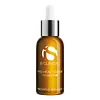What's inside
What's inside
 Key Ingredients
Key Ingredients

 Benefits
Benefits

 Concerns
Concerns

 Ingredients Side-by-side
Ingredients Side-by-side

Water
Skin ConditioningAscorbic Acid
AntioxidantLaureth-4
EmulsifyingAlcohol Denat.
AntimicrobialPentylene Glycol
Skin ConditioningPropylene Glycol
HumectantTriethanolamine
BufferingTocopherol
AntioxidantGlycerin
HumectantBioflavonoids
Skin ConditioningRetinol
Skin ConditioningOlea Europaea Leaf Extract
PerfumingZinc Sulfate
AntimicrobialPolyporus Umbellatus Extract
Skin ProtectingArbutin
AntioxidantPolysorbate 20
EmulsifyingPhenoxyethanol
PreservativeWater
Skin ConditioningDiglycerin
HumectantTrideceth-9
EmulsifyingEthylhexyl Methoxycrylene
Skin ConditioningPEG-40 Hydrogenated Castor Oil
EmulsifyingPanthenol
Skin ConditioningRetinol
Skin ConditioningAscorbyl Tetraisopalmitate
AntioxidantAscorbyl Palmitate
AntioxidantTocopherol
AntioxidantAllantoin
Skin ConditioningCholesterol
EmollientSphingolipids
EmollientPhospholipids
Skin ConditioningLecithin
EmollientHydrogenated Palm Glycerides Citrate
EmollientPolyacrylate Crosspolymer-6
Emulsion StabilisingPolysorbate 20
EmulsifyingEthylhexylglycerin
Skin ConditioningT-Butyl Alcohol
PerfumingGlyceryl Stearate
EmollientPotassium Sorbate
PreservativeGlyceryl Oleate
EmollientSodium Citrate
BufferingCitric Acid
BufferingBHT
AntioxidantBHA
AntioxidantPhenoxyethanol
PreservativeDisodium EDTA
Sodium Hydroxide
BufferingWater, Diglycerin, Trideceth-9, Ethylhexyl Methoxycrylene, PEG-40 Hydrogenated Castor Oil, Panthenol, Retinol, Ascorbyl Tetraisopalmitate, Ascorbyl Palmitate, Tocopherol, Allantoin, Cholesterol, Sphingolipids, Phospholipids, Lecithin, Hydrogenated Palm Glycerides Citrate, Polyacrylate Crosspolymer-6, Polysorbate 20, Ethylhexylglycerin, T-Butyl Alcohol, Glyceryl Stearate, Potassium Sorbate, Glyceryl Oleate, Sodium Citrate, Citric Acid, BHT, BHA, Phenoxyethanol, Disodium EDTA, Sodium Hydroxide
Ingredients Explained
These ingredients are found in both products.
Ingredients higher up in an ingredient list are typically present in a larger amount.
Phenoxyethanol is a preservative that has germicide, antimicrobial, and aromatic properties. Studies show that phenoxyethanol can prevent microbial growth. By itself, it has a scent that is similar to that of a rose.
It's often used in formulations along with Caprylyl Glycol to preserve the shelf life of products.
Polysorbate 20 is made by combining ethoxylation of sorbitan, ethylene oxide, and lauric acid. It is a mild cleansing agent, surfactant, and emulsifier.
As a surfactant, it helps collect dirt and oils for washing. Emulsifiers prevent oils and water from separating.
Polysorbate 20 also adds scent to a product. Since it is made using sorbitol, it has a sweet scent. Sorbitol can also be found in fruits such as apples and peaches.
The lauric acid used to create Polysorbate 20 is often derived from coconuts.
Polysorbate 20 may not be fungal acne safe.
Learn more about Polysorbate 20Retinol is a gold-standard ingredient for anti-aging. It is a form of Vitamin A and belongs to the class of retinoids that also includes tretinoin.
Why is retinol famous?
It has the most scientific studies backing up its skin benefits out of all the non-prescription ingredients.
Retinol is proven to:
This is why retinol is effective at removing wrinkles, fading dark spots, treating acne, and reducing the appearance of pores.
Studies show retinol is less effective when exposed to UV. Be sure to look for appropriate packaging to keep your retinol potent (similar to Vitamin C).
Using retinol or any retinoids will increase sun-sensitivity in the first few months. Though studies show retinoids increase your skin's natural SPF with continuous use, it is best to always wear sunscreen and sun-protection.
We recommend speaking with a medical professional about using this ingredient during pregnancy.
Retinol may cause irritation in some people, so be sure to patch test. Experts recommend 'ramping up' retinol use: start using this ingredient once a week and work up to using it daily.
Read about Tretinoin
Learn more about RetinolTocopherol (also known as Vitamin E) is a common antioxidant used to help protect the skin from free-radicals and strengthen the skin barrier. It's also fat soluble - this means our skin is great at absorbing it.
Vitamin E also helps keep your natural skin lipids healthy. Your lipid skin barrier naturally consists of lipids, ceramides, and fatty acids. Vitamin E offers extra protection for your skin’s lipid barrier, keeping your skin healthy and nourished.
Another benefit is a bit of UV protection. Vitamin E helps reduce the damage caused by UVB rays. (It should not replace your sunscreen). Combining it with Vitamin C can decrease sunburned cells and hyperpigmentation after UV exposure.
You might have noticed Vitamin E + C often paired together. This is because it is great at stabilizing Vitamin C. Using the two together helps increase the effectiveness of both ingredients.
There are often claims that Vitamin E can reduce/prevent scarring, but these claims haven't been confirmed by scientific research.
Learn more about TocopherolWater. It's the most common cosmetic ingredient of all. You'll usually see it at the top of ingredient lists, meaning that it makes up the largest part of the product.
So why is it so popular? Water most often acts as a solvent - this means that it helps dissolve other ingredients into the formulation.
You'll also recognize water as that liquid we all need to stay alive. If you see this, drink a glass of water. Stay hydrated!
Learn more about Water